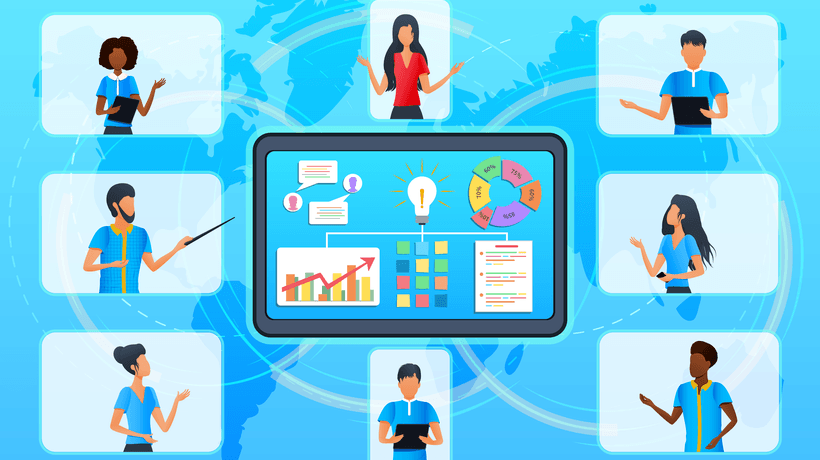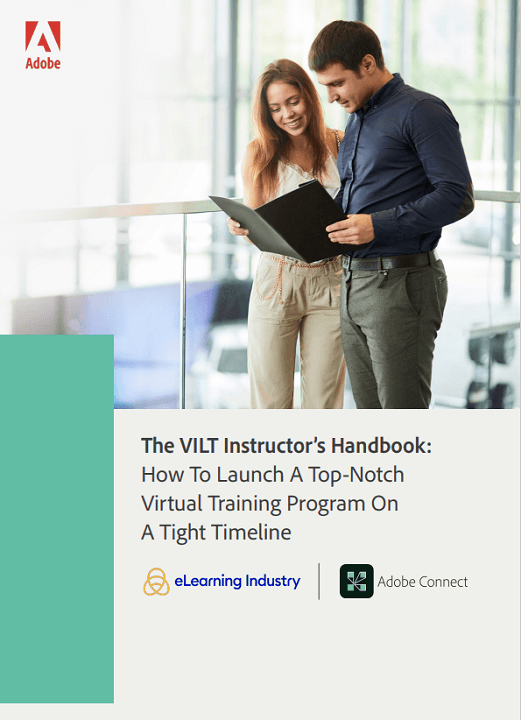
How To Create Amazing Virtual Experiences For Popular L&D Use Cases
Virtual Experiences For Top L&D Use Cases
This guide will help you develop amazing virtual sessions that stick with employees and partners for months (or years) to come. Each section features top virtual training activities, icebreakers, and tie-in JIT support resource ideas to give you a head start.
We also explore why organizations should create a custom virtual training program for each use case to build the L&D excitement and facilitate knowledge sharing.

eBook Release
The VILT Instructor’s Handbook: How To Launch A Top-Notch Virtual Training Program On A Tight Timeline
Learn how to launch an awe-inspiring virtual training program for your team!
5 Popular Use Cases For Virtual Training
1. Onboarding
First-day jitters can turn even the most confident new hire into a nervous wreck. Onboarding virtual training preps them for challenges ahead. More importantly, it allows them to break the ice and get to know their peers in a less formal setting. In many ways, VILT breaks down the communication barriers and fosters an emotional connection between co-workers, instructors, and team leaders. Everyone has the opportunity to ask questions in real-time and get immediate feedback, as well as reflect on personal areas for improvement before they venture into the workplace.
Inspired Virtual Training Ideas
- Remote meet-and-greets: New hires get to socialize with coworkers and evaluate fresh perspectives.
- Quick knowledge checks: Evaluate employees to see how much they know and set a benchmark (for ongoing development).
- Virtual tours: Provide the opportunity to explore their new workspace and/or work-related software from afar.
- Interactive employee handbooks: Cover company policies, work tasks, and job responsibilities virtually.
2. Leadership Training
Leaders might set the example, but they need ongoing support to support their teams in turn. Virtual training facilitates continual skill-building and self-assessment. They’re able to learn from industry insiders, as well as fellow managers who have niche expertise. Furthermore, VILT leadership training enables them to step into the role of mentor/coach if they have unique insights to offer.
Inspired Virtual Training Ideas
- Story swaps: Exchange on-the-job tales to evaluate different approaches and reflect on performance behaviors. This is also a great ice-breaker activity.
- Bite-sized guides: Highlight task protocols, rules and regulations, and managerial skills. Keep it targeted for quick knowledge assimilation and JIT support.
- “Parting gift” infographics: Create a fresh infographic for each VILT session to reinforce what they’ve learned. Don’t let leaders leave empty-handed.
- Troubleshooting tips: Ask experienced leaders to share their recent challenges and seek advice from fellow managers.
3. Performance Management
This broad L&D umbrella covers everything from improving behaviors to reinforcing positive habits. It also involves continual performance support, coaching, and other essential ingredients to help employees achieve their full potential. Thus, virtual training is a perfect fit since staff members don’t have to wait for monthly ILT sessions or annual performance evaluations to disclose personal pain points. For example, instructors can host group virtual training events based on shared skill, knowledge, or performance gaps.
Inspired Virtual Training Ideas
- Goal-setting workshop: Host a targeted workshop that’s all about setting manageable goals and learning how to track them effectively.
- Career planning chart: Every staff member creates a chart that outlines their career trajectory and where they see themselves six months or even six years from now.
- Peer review: Peer pairs discuss their goals and areas for improvement every month to improve accountability. This can also be paired with a peer mentoring contract.
- Do and don’t demos: Produce quick videos that showcase positive and negative habits in the workplace to put everything into context.
4. Remote Workforce Development
The COVID crisis has made many employees feel isolated and disconnected from their peers. Of course, there’s the geographical distance to consider, but the emotional repercussions are often more prevalent. Virtual training empowers employees because they come face to face with instructors and coworkers. They’re able to hear subtle nuances in their voice or see facial expressions, which humanizes the experience. As a result, you can deploy remote workforce development virtual training courses that bring people together without sacrificing their learning journeys.
Inspired Virtual Training Ideas
- Professional priorities checklist: Ask employees to create a checklist of their top development priorities based on current gaps and goals.
- Upskilling opportunities: Launch skill-specific support libraries that are categorized by skill or core competencies.
- Shadowing sessions: Break employees off into pairs or teams, then allow them to experience a typical workday from their peers’ point of view.
- Barrier breakdowns: Encourage employees to challenge their assumptions or limiting beliefs through group discussions.
5. Sales Enablement
Sales teams these days are often on the go. Even if they work from home, busy schedules keep them from participating in “traditional” eLearning courses and on-site ILT sessions. That said, virtual training is often more flexible assuming it’s meticulously designed to be just as effective too. If they miss the live event, they can watch the recorded version and still learn from the instructor’s or guest speaker’s insights. Another benefit is being able to gather valuable feedback from external partners, and sales channels since virtual training allows space for a two-way dialogue.
Inspired Virtual Training Ideas
- Sales pitch presentations: Invite top sales performers to demo their pitches and offer pointers.
- Product pop quizzes: Test sales employees on their product know-how, from features to innovative uses.
- Soft skill-builders: Create microlearning tutorials and video demos that highlight interpersonal skills in action.
- Customer anecdotes: Encourage employees and partners to speak from personal experience and share how they overcame customer apprehensions.
Summary
Bear in mind that these activities are just springboards to help you kick-start your virtual training program. Adobe Connect is a versatile platform that allows you to launch engaging live virtual training experiences, regardless of your industry or staff size. You have the power to transform on-site ILT sessions into immersive and interactive synchronous virtual training events, webinars, and L&D workshops for your entire team. It’s not just about giving them an online space to meet and greet clients but empowering staffers to seize informal training opportunities.
Whether you’re just starting to dive into virtual training strategies or would like to improve your existing VILT approach, this guide is an essential read. Download the eBook The VILT Instructor’s Handbook: How To Launch A Top-Notch Virtual Training Program On A Tight Timeline to enact meaningful change and leverage the full power of online training platforms.
Stay connected with us on social media platform for instant update click here to join our Twitter, & Facebook
We are now on Telegram. Click here to join our channel (@TechiUpdate) and stay updated with the latest Technology headlines.
For all the latest Education News Click Here
For the latest news and updates, follow us on Google News.


